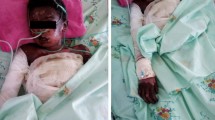Abstract
Toxic epidermal necrolysis (TEN) is a rare, life-threatening mucocutaneous condition, which may occur as an adverse reaction to a number of medications. The anitifungal agent, fluconazole, has been associated with TEN in limited reports, mainly in adults with HIV infection. We describe the case of a neonate with liver disease who developed TEN, presumably induced by fluconazole.

Similar content being viewed by others
References
Roujeau JC, Stern R . Medical progress: severe cutaneous reactions to drugs. N Engl J Med 1994; 331: 1272–1285.
Ofoma UR, Chapnick EK . Fluconazole induced toxic-epidermal necrolysis: a case report. Cases J 2009; 2: 9071.
George J, Sharma A, Dixit R, Chabra N, Sharma S . Toxic epidermal necrolysis caused by fluconazole in a patient with human immunodefiency virus infection. J Pharmacol Pharmacother 2012; 3: 276–278.
Paquet O, Pierard GE, Quatresooz P . Novel treatments for drug-induced toxic epidermal necrolysis (Lyell’s Syndrome). Int Arch Allergy Immunol 2005; 136: 205–216.
Azon-Masoliver A, Vilaplana J . Fluconazole-induced toxic epidermal necrolysis in a patient with human immunodeficiency syndrome. Dermatology 1993; 187: 268–269.
Gussenhoven MJ, Haak A, Peereboom-Wynia JD, Van’t Wout JW . Stevens-Johnson syndrome after fluconazole. Lancet 1991; 338: 120.
Craythorne E, Creamer D . Stevens–Johnson syndrome due to prophylactic fluconazole in two patients with liver failure. Clin Exp Dermatol. 2009; 34 (7): e389–e390.
Pasmatzi E, Monastirli A, Georgiou S, Sqouros G, Tsambaos D . Short-term and low-dose oral fluconazole treatment can cause Steven-Johnson-Syndrome in HIV-negative patients. J Drug Dermatol 2011; 10: 1360.
Levi N, Bastuji-Garin S, Mockenaupt M, Roujeau JC, Flahault A, Kelly JP et al. Medications as risk factors of Stevens-Johnson syndrome and toxic epidermal necrolysis in children: a pooled analysis. Pediatrics 2009; 123 (2): e297–e304.
Egunsola O, Adefurin A, Fakis A, Jacqz-Aigran E, Choonara I, Sammons H et al. Safety of fluconazole in paediatrics: a systematic review. Eur J Clin Pharmacol 2013; 69: 1211–1212.
Author information
Authors and Affiliations
Corresponding author
Ethics declarations
Competing interests
The authors declare no conflict of interest.
Rights and permissions
About this article
Cite this article
Islam, S., Singer, M. & Kulhanjian, J. Toxic epidermal necrolysis in a neonate receiving fluconazole. J Perinatol 34, 792–794 (2014). https://doi.org/10.1038/jp.2014.92
Received:
Revised:
Accepted:
Published:
Issue Date:
DOI: https://doi.org/10.1038/jp.2014.92
- Springer Nature America, Inc.
This article is cited by
-
Fluconazole
Reactions Weekly (2015)




